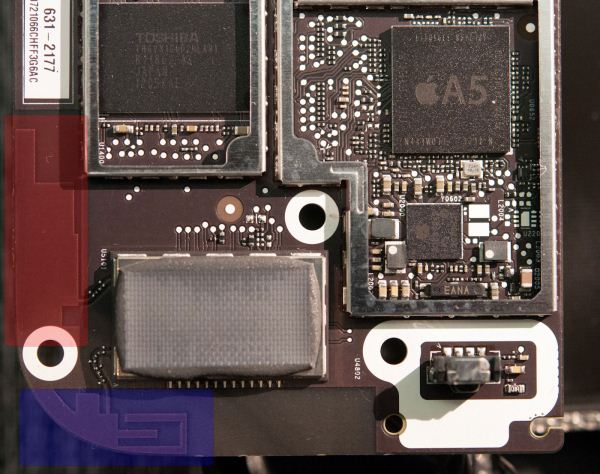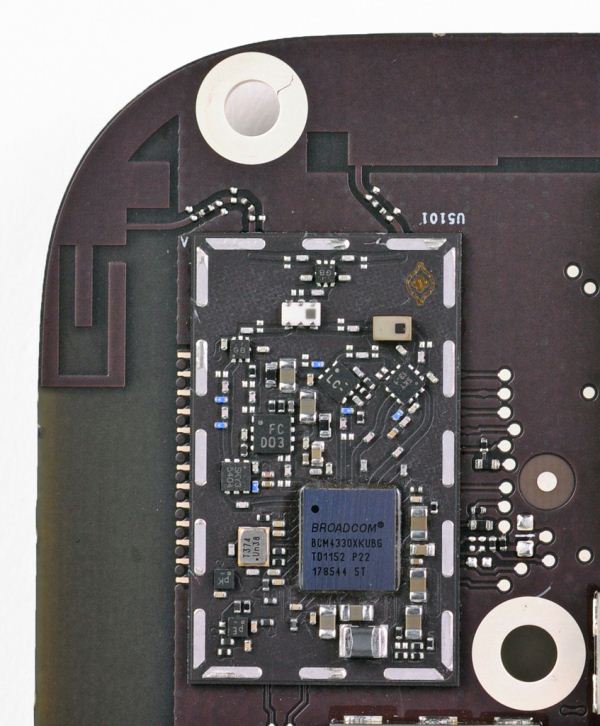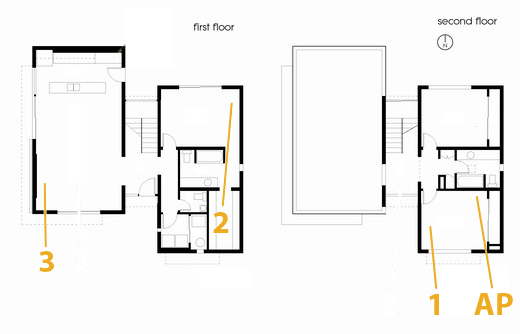Apple TV 3 (2012) Short Review - 1080p and better WiFi
by Brian Klug on March 21, 2012 4:21 PM ESTI touched on the fact that the Apple TV 3 now has two WiFi antennas printed on its PCB. The first appears to be of similar design to the Apple TV 2, and it's obvious from visual inspection that this is the case. The second is adjacent and shares the same ground plane / metal layer.

Antenna 1 (Encircled in blue), Antenna 2 (Encircled in red)
In addition, the Apple TV 3 also moves from Broadcom's BCM4329 802.11a/b/g/n and BT 2.0+EDR combo chip to BCM4330 802.11a/b/g/n and BT 4.0 combo chip which we've seen in the iPad 3, iPhone 4S, and countless other mobile devices. Seeing two RF chains, you might be led to think that the Apple TV 3 has 2x2:2, however this is not the case as the device still will only connect at 65 Mbps - single spatial stream, 20 MHz wide channels with the long guard interval. The maximum PHY rate and presence of 2.4 and 5 GHz band support is unchanged from Apple TV 2.

BCM4330 - Courtesy iFixit
One of the main complaints that I read online of the Apple TV 2 was its performance on 2.4 GHz. If you're living in the Apple ecosystem with an Airport Extreme or have a 5 GHz AP, this previously is something you could've not noticed entirely. In addition, multimedia streaming seems to be the ideal use case for 5 GHz WLAN thanks to both the ability to run 40 MHz channels and deal with less congestion. However, for users with 2.4 GHz networks, gain on that band is important.
It's obvious that the inclusion of a second WLAN chain and antenna is an attempt to improve RF performance further, even though the jump from 720p to 1080p for iTunes content doesn't increase bitrate very much at all (more later). To show just how much things have changed, I turned to the FCC documents for both Apple TV models which spell out antenna gain. Interestingly enough, the FCC also had internal photos up and posted the day the Apple TV 3 went on sale, which could've saved everyone some teardown time.
| Apple TV 2 and 3 - Antenna Gain | ||||||||
| Antenna | Apple TV 3 (A5) (BCGA1427) | Apple TV 2 (A4) (BCGA1378) | ||||||
| Band (MHz) | Ant 1 (dBi) | Ant 2 (dBi) | Ant 1 (dBi) | |||||
| 2400-2483.5 | 3.7 | - | 0.49 | |||||
| 5150-5120 | 4.5 | 2.4 | 2.76 | |||||
| 5250-5350 | 4.1 | - | 2.95 | |||||
| 5470-5725 | 4.5 | - | 4.09 | |||||
| 5745-5850 | 4.6 | - | 1.42 | |||||
The table above contains the antenna gains for both models, and you can immediately see just how little gain there was previously for the Apple TV 2 on 2.4 GHz. Gain is now majorly improved on the 2.4 GHz band, and also improved on other parts of the 5 GHz band. You'll notice that antenna 2 on the Apple TV 3 only gets used (at least for transmit) on the 5.2 GHz band - channels 36 to 48. This is the small band below the DFS-enabled 5 GHz band (52-140). Remember that the "best" 5 GHz channels in the USA are the traditional 802.11a channels 149-165 since you can run with higher power. BCM4330 supports optional external antenna diversity - it's entirely possible this is also being used on the receive side.
So what does this translate to in terms of actual RF performance now? To find out, I tested the Apple TV at three places in my house where I ran the previous model. Downstairs in my home theater shelf, a location which is awful for WiFi (I've run powerline here), downstairs in the bedroom (ironically on a 720p TV), and upstairs in my office on another TV right next to the AP for a baseline.

Location 1 corresponds to the office environment right next to the AP, location 2 is the bedroom TV, and location 3 is the main TV cabinet. I setup the Apple TV 2 and 3 in all three locations like I normally would and fired up the Netflix example short test videos to ensure constant network traffic. I then watched the received signal strength and noise metrics reported from an Airport Extreme 5th gen.
| Apple TV 2 and 3 - Antenna Gain | |||||||||||||
| Antenna | Apple TV 3 (A5) (BCGA1427) | Apple TV 2 (A4) (BCGA1378) | |||||||||||
| Location | Signal (dBm) | Noise (dB) | Rate (Mbps) | Band (GHz) | Signal (dBm) | Noise (dB) | Rate (Mbps) | Band (GHz) | |||||
| 1 - Office | -47 | -87 | 65 | 5 | -50 | -90 | 65 | 5 | |||||
| 2 - Bedroom | -71 | -90 | 65 | 2.4 | -78 | -90 | 58 | 5 | |||||
| 3 - Living Room | -69 | -85 | 65 | 2.4 | -80 | -90 | 52 | 5 | |||||
I have my network setup with one SSID for both 2.4 and 5 GHz networks, and let devices choose which band. The Apple TV 3 seems to have a higher affinity for 2.4 GHz in the more difficult downstairs propagation environments, no doubt which comes from it being able to negotiate a higher PHY rate on 2.4 GHz as opposed to 5 GHz. In all three places, it latches onto the single spatial stream 20 MHz channel long guard interval 65 Mbps rate, where the Apple TV 2 previously selected lower MCS categories on 5 GHz.
The takeaway is that the new Apple TV 3 gets better WiFi reception on both bands and thus can be placed further from the AP. This is something which no doubt will be much appreciated by users who have challenging home theater locations. Part of the reason is also no doubt to accommodate 1080p versus 720p content, though for iTunes content bitrate only changes from ~4 Mbps to ~5 Mbps. The other big new bandwidth consumer is of course iTunes Match. Obviously it goes without saying that Apple's media streamer device needs to have good connectivity to do its job, and the WiFi improvement makes a dramatic difference if you don't already have ethernet wherever you've located your TV.










37 Comments
View All Comments
nfineon - Wednesday, March 21, 2012 - link
This is exactly the review I was hoping to find, with a more technical explanation of the hardware underpinnings that Apple doesn't really care to advertise. I personally have 6 Apple TV's throughout the house in all the key rooms and we get tremendous usage out of the Apple TV. Sitting at the dinner table together being able to instantly share our photos and videos via airplay is very nice, but a lot of people also don't realize that you can facetime on the big screen using the airplay mirroring function (try FaceTime on a 100" Projector/LCD and your mother won't ever want to use the small screen again).It's good to hear the antenna gain as improved, and i was really really hoping they would bump up to 2 spacial streams to get us 130 mb/s as Airplay of 1080p videos takes 2-3 times longer to load from the iPhone 4s camera as compared to the traditional 720p. That would also necessitate a bump up in all the iPad/iPhone devices as well given that all of them are also limited to 65 mb/s.
But the #1 usage of the Apple TV's in our house is in streaming our movie/show collection from our Synology NAS in any format. You can't do this with the default firmware, which is why we use the FireCore firmware that keeps the same interface and functions as the original Apple TV while adding the ability to stream from any network device in any format. Also lets you install XBMC, plex and a few other handy tools if you want to go the extra mile but that alone has made the Apple TV increase in value considerably!
Brian Klug - Thursday, March 22, 2012 - link
I was hoping for 2 spatial stream WLAN connectivity as well, unfortunately it just isn't here yet.No doubt future revisions of the Apple TV will use either BCM43241 (which is 2x2:2 and dual-band), instead of the direct BCM4330 successor, BCM4334 (which is still 1 spatial stream, but built on 45nm instead of 4330's 65nm).
-Brian
Shaun-T - Thursday, March 22, 2012 - link
What I want to know is, why doesn't Apple allow the refresh rate to be 24fps on the Apple TV 3? I read somewhere that the Apple TV 2 only output at 25 or 30fps as 720p/24 wasn't an official standard, but 1080p/24 is.So now we have a device that supports 1080p and the content sold on iTunes is 1080p/24. As BluRay players and and modern HD televisions use this, I don't understand why the the Apple TV 3 only outputs at 25 or 30fps. In either of those refresh rates, you get a stutter every second or so when playing 24fps content. It's really annoying.
MGSsancho - Thursday, March 22, 2012 - link
This device is not for what apple calls videohpines who wan to play BD ISOs, DVD ISOs and the llike. It is designed to play anything found on iTunes. If you can get other stuff to play then that is just the gravy on top. For things that are actully useful (at least on current offerings) we are forced to jailbreak it. :)cjs150 - Friday, March 23, 2012 - link
What an incredible oversite (bit like Apple advertising the Ipad 3 as 4G in Europe when it is not).But given that Intel are/were (what is latest position) incapable of producing a chip which outputed at the correct frame rate either (unlike AMD) why should we be surprised.
BD frame rate are not exactly an obscure or new standard!
I guess I will just drop this off my list of things to buy at least until someone jailbreaks it and gets the right frame rate and XBMC on it
solipsism - Saturday, March 24, 2012 - link
Why doesn't Europe follow the ITU's definition of 4G?alpha64 - Friday, March 23, 2012 - link
Your comment in the third page, which reads:In addition, the Apple TV 3 also moves from Broadcom's BCM4329 802.11a/b/g/n and BT 2.0+EDR combo chip to BCM4330 802.11a/b/g/n and BT 4.0 combo chip which we've seen in the iPad 2, iPhone 4S, and countless other mobile devices.
Should say "we've seen in the iPad 3, iPhone 4S, ..."
The iPad 2 had the same BCM4329 as the iPad and iPhone 4:
http://www.ifixit.com/Teardown/iPad-2-Wi-Fi-Teardo...
jpcuve - Monday, March 26, 2012 - link
I purchased one too. Since the last upgrade it plays all my movies correctly (600+), with the subtitles.locust76 - Tuesday, March 27, 2012 - link
I have the new Apple TV and a 40-inch 1080p Sony LCD, and I definitely notice a new sharpness and realism to the images and video from iTunes.I think it's also worth mentioning what this thing can do outside of the iTunes ecosphere: I ripped the Star Wars Ep 4 Blu-Ray and compressed it down to iTunes-level specifications, but with almost 10 Mbit/s video bitrate and DD 5.1.
The Apple TV handled it with no problem, save for buffering issues which prevented me from skipping wildly throughout the movie without longer pauses. However, when the movie was playing, it played without stuttering with exceptional picture quality, considering I was running a video stream through it that was probably double Apple's intended bitrate...
kwrzesien - Wednesday, March 28, 2012 - link
Is this with wired Ethernet or Wi-Fi?